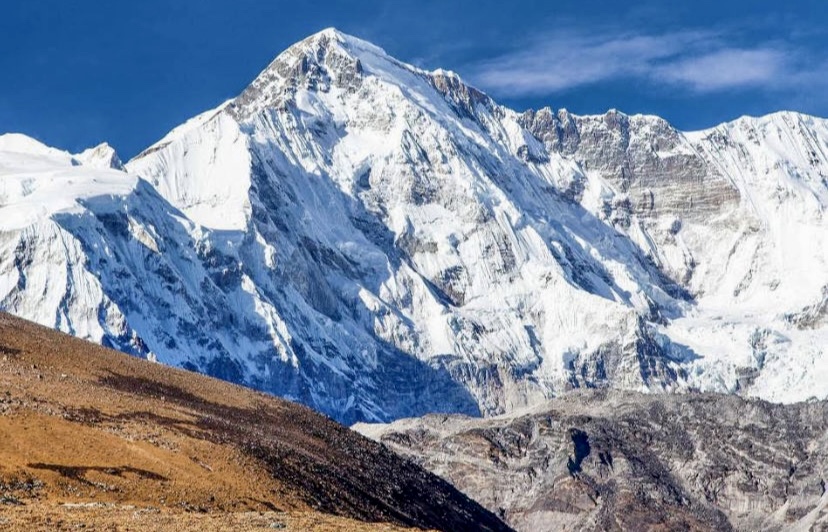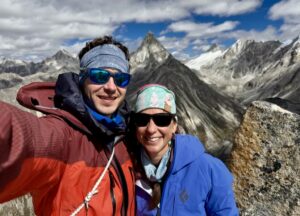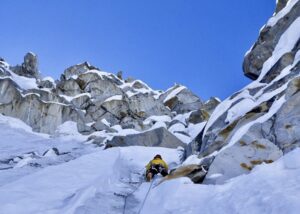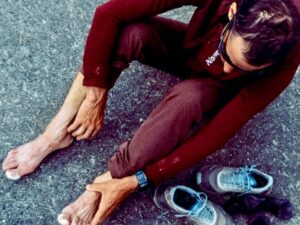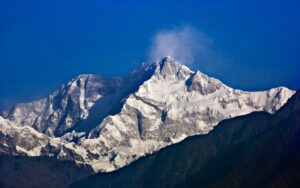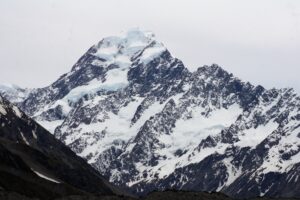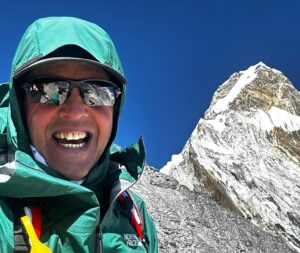The sixth-highest mountain in the world, Cho Oyu is located 20km west of Everest, on the border between Tibet and Nepal. We have already written a brief climbing history of the mountain, as well as a history of climbing Cho Oyu from Tibet. Today, we will examine the climbing routes on the Nepalese side of this so-called Turquoise Goddess.
The various climbing routes on Cho Oyu include both the southern (Nepalese) and northern (Tibetan) sides of the peak. The comparatively easy normal route goes up the northwest side in Tibet. The Nepalese side is technically demanding, with steep faces, a high risk of avalanches, and unpredictable weather. That’s why almost all commercial expeditions use the Tibetan route. Despite its difficulty, some notable climbs do take place on the Nepalese side.
In October 1978, a small Austrian-German team, led by Eduard Koblmueller, embarked on an unauthorized ascent of Cho Oyu’s formidable Southeast Face. It was a bold goal; Reinhold Messner had deemed the route unclimbable. The team, consisting of Koblmueller, Alois Furtner, Peter Von Gizicky, Gerhard Haberl, and Herbert Spousta, carried 250kg of gear to a 5,000m Base Camp, operating under a trekking permit for Gokyo.
Facing a 3,000m wall of ice-saturated rock, avalanche-prone plateaus, and steep ice troughs, they established camps at 6,000m and 7,400m, fixing ropes through the treacherous sections. They didn’t use supplemental oxygen or Sherpa support.
On October 27, Koblmueller and Furtner reached the summit at 6 pm, witnessing Everest as the sun set. Haberl had turned back at 8,000m because of frostbitten toes, and Gizycki and Spousta retreated at 7,800m. Heavy snowfall trapped the team at 6,600m without food or fuel, but they avoided avalanches and had all descended safely by November 1.
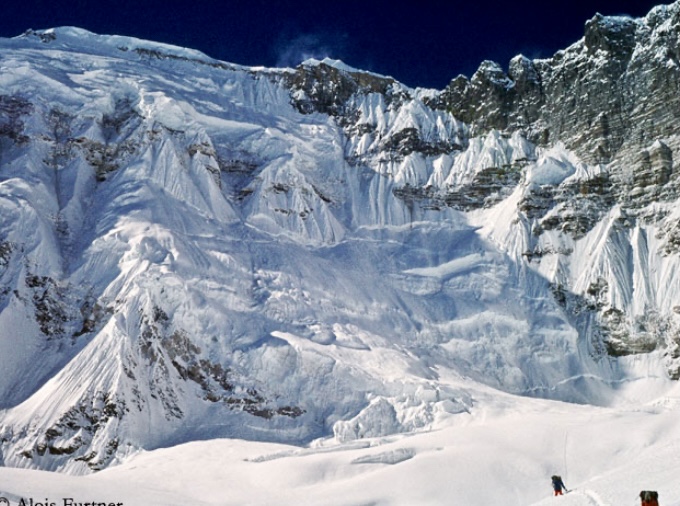
Cho Oyu’s Southeast Face. Photo: Alois Furtner
Controversy
The ascent, described by Koblmueller as his most challenging climb, sparked controversy. Stefan Woerner and Haberl later questioned whether the team climbed the Southeast Face or the easier Tichy route (the first ascent route of 1954). In 1981, Japanese climbers found no evidence of prior ascents on the southern face, and Gunter Hauser and the German Alpine Club doubted the summit claim.
However, Reinhold Messner saw the team’s photos and argued that they did climb the Southeast Face, as claimed. Jan Boon, who met the three Austrians in the Khumbu, also supported their claim, noting their description of a unique Tibetan view from the summit.
Nepal’s Ministry of Tourism banned the group for five years for climbing without a permit.
Winter first by the Southeast Pillar
In February 1985, a Polish-Canadian expedition led by Andrzej Zawada achieved the first winter ascent of Cho Oyu. They climbed via the challenging Southeast Pillar, a route with brutal conditions. The team, including Jerzy Kukuczka, Zygmunt A. Heinrich, Maciej Berbeka, and Maciej Pawlikowski, faced a perilous 1,000m ridge fraught with rockfall risk. They established five camps up to 7,600m and didn’t use bottled oxygen. With only four members to carry gear, they struggled with logistics, moving a Camp 3 tent to serve as Camp 5.
On February 12, Berbeka and Pawlikowski summited after reaching 200m below the peak by 11 am, battling mist and technical difficulties. Kukuczka and Heinrich, delayed by differing acclimatization — Kukuczka was fresh from summiting Dhaulagiri on January 21 — followed on February 15. They hoisted Polish, Nepalese, and German flags, stayed 20 minutes taking photos, and enjoyed the sunset views despite temperatures of -25°C and fierce winds.
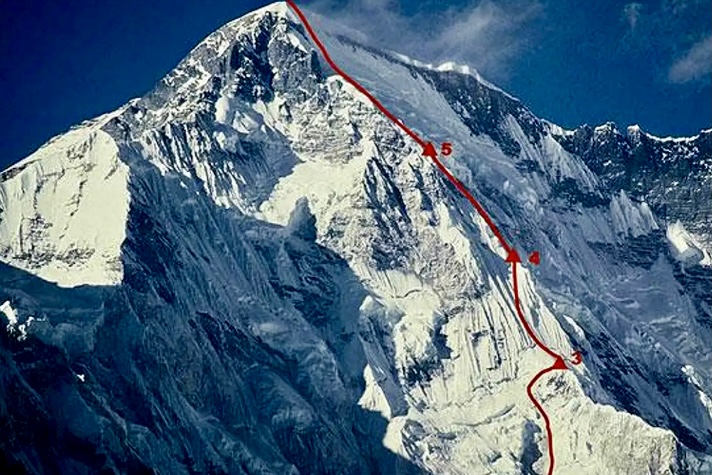
The Polish Southeast Pillar route. Photo: Summitpost. Topo by Janusz Kurczab
The descent proved complicated: Kukuczka fell four meters, and wary of darkness, the pair bivouacked at 7,920m before reaching Camp 5 on February 16. Kukuczka suffered slight frostbite on his fingers and toes, while a rockfall leg injury had earlier sidelined Heinrich. Earlier, Dmoch withdrew because of heart issues.
This ascent marked Kukuczka’s eighth 8,000’er and his second in a month. He thus became the first to ascend two 8,000m peaks in Nepal in such a short period.
New route: Southwest Face up, West Ridge down
In the autumn of 1990, Voytek Kurtyka, Erhard Loretan, and Jean Troillet ascended Cho Oyu’s Southwest Face and descended by the West Ridge without supplemental oxygen. In their report for The Himalayan Database, they explained that the most difficult part of the climb was a few sections with deep snow and rock just above a couloir.
Japanese climber Yasushi Yamanoi established a new variation of the 1990 route in the autumn of 1994. He summited on September 23 without bottled oxygen.
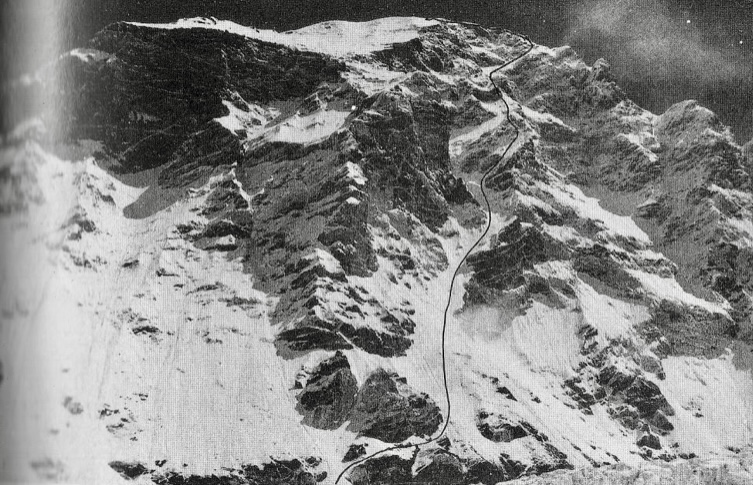
The 1990 route on Cho Oyu’s Southwest Face. Photo: Himalayan Club
Southeast Ridge- East Ridge route
In the autumn of 1991, a Russian expedition led by Sergey Efimov successfully established a new route on the Southeast Ridge- East Ridge. Other climbers had previously attempted this route, without success.
The team consisted of 14 Russians, one Ukrainian, and one Bashkir (a Turkic ethnic group from Russia).
They established their Base Camp northeast of Gyazumpa between two lakes. They navigated the complex East Ridge by setting up camps and fixing ropes at key sections:
– 100m through an icefall below Camp 2
– 120m just before Camp 2
– 400m between Camp 2 and Camp 3
– 730m from Camp 3 to Camp 4
– 320m between Camp 4 and Camp 5
– 80m above Camp 5
Above Camp 5, the route followed the ridge into a 70m-deep gully with mixed rock, ice, and snow. The rock was brittle, although some areas allowed them to install bolts. The gully’s north and south faces featured 3,000m rock walls descending from the ridge, with snow atop and steep rock faces beyond the gully.
On the Tibetan side, a couloir ran parallel, and a shelf on the far west side allowed a critical 200m traverse on 80° rock faces, described as the most difficult part of the climb. This traverse led back to the border ridge toward the summit.
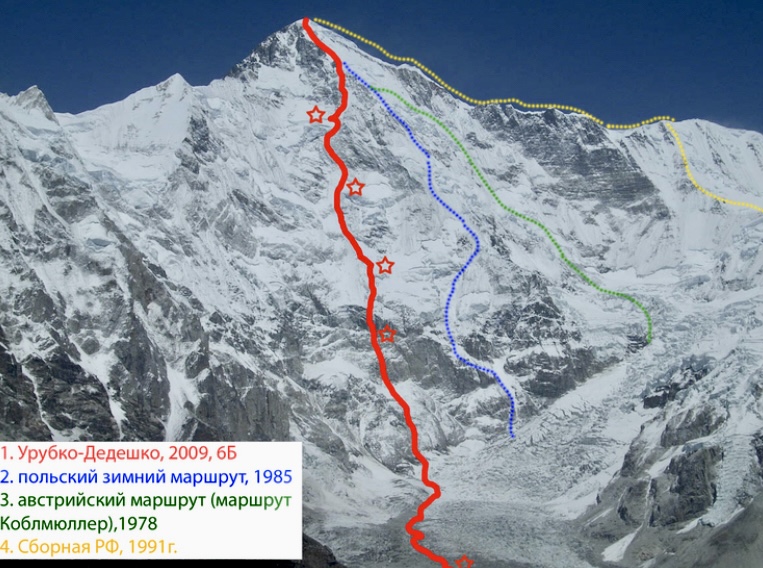
The Russian line of 1991, marked in yellow. Photo: Mountain.ru
Summit push
After establishing Camp 4, the team rested at lower camps. On October 15, a group scouted and fixed ropes beyond Camp 4. Three days later, a summit attempt from Camp 4 reached 7,900m (beyond the gully) by 1 pm, but they aborted the push because it was too late, and climbing in darkness would be very hard.
On October 19, the next summit party moved equipment from Camp 4 to establish Camp 5 at 6,950m. They arrived at 3 pm and fixed 100m of rope, then spent the night.
On October 20, starting at 8 am, Ivan Plotnikov, Eugeny Vinogradsky, Alexsander Yakovenko, Valeri Pershin, and Sergey Bogomolov summited. Plotnikov, Vinogradsky, and Yakovenko reached the top around 11 am, followed by Pershin and Bogomolov nearly two hours later, all without supplemental oxygen.
Yuri Grebeniuk, a surgeon, attempted the summit but turned back at 8,000m when his fingers began to freeze. He returned to Camp 5 at 1:30 pm with the first three summiters. They all spent the night at Camp 5.
Tragedy on descent
On October 21, the team descended from Camp 5 to Camp 3, leaving the Camp 5 tent behind but taking the sleeping bags. During the descent through the gully, a falling rock struck Grebeniuk on the forehead while he was climbing a 15m section.
Helmets were not worn above Camp 3, as rockfall was not anticipated. Grebeniuk sustained a deep wound and died within a minute. His teammates couldn’t carry his body down because of the difficult terrain, so they left him in a sleeping bag on a shelf in the gully. During attempts to move the body, Pershin frostbit his fingers, which turned black but were expected to heal. He used oxygen that night in Camp 3.
Timofeev also sustained a head wound from a falling rock, and Pogorelov had a painful nerve issue in one leg that required a week’s rest at Base Camp.
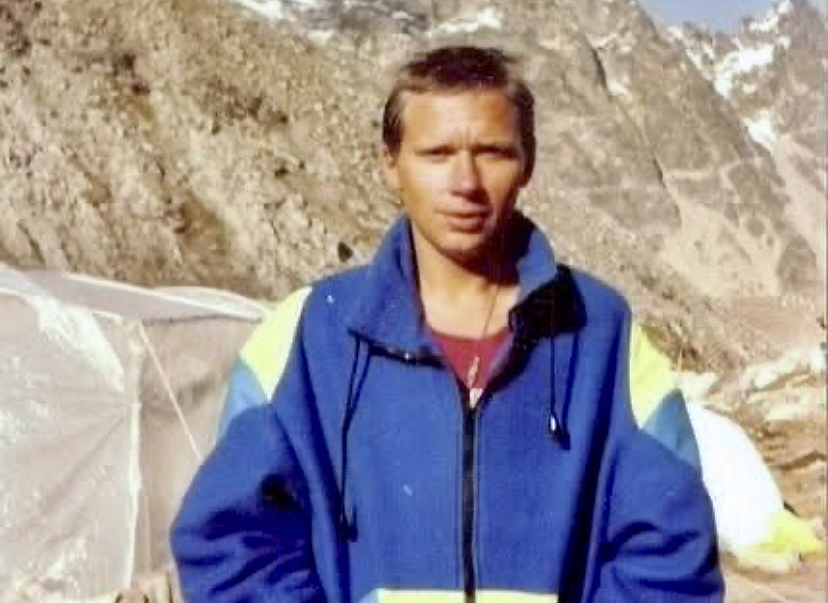
Yuri Grebeniuk in 1991. Photo: Elena Laletina
Reincarnation: the Southeast Face Direct
In the spring of 2009, Denis Urubko and Boris Dedeshko from Kazakhstan embarked on a daring alpine-style ascent of the Southeast Face via a committing new route. Urubko, captivated by the face since 2001, described it as “terrifying and beautiful” in the American Alpine Journal.
The duo flew to Lukla on April 5 and began their acclimatization during the trek to Namche. They climbed Chhukung Peak to 5,800m, spent two nights there, and later reached 7,100m on the Ngozumba massif’s south face.
By April 14, they established Base Camp at 5,100m on the Ngozumba Glacier’s moraine. During a reconnaissance on April 25, they set an Advanced Base Camp at 5,300m on the Lungsampa Glacier. Urubko, battling a chest condition, briefly descended to Namche for recovery, returning by May 4.
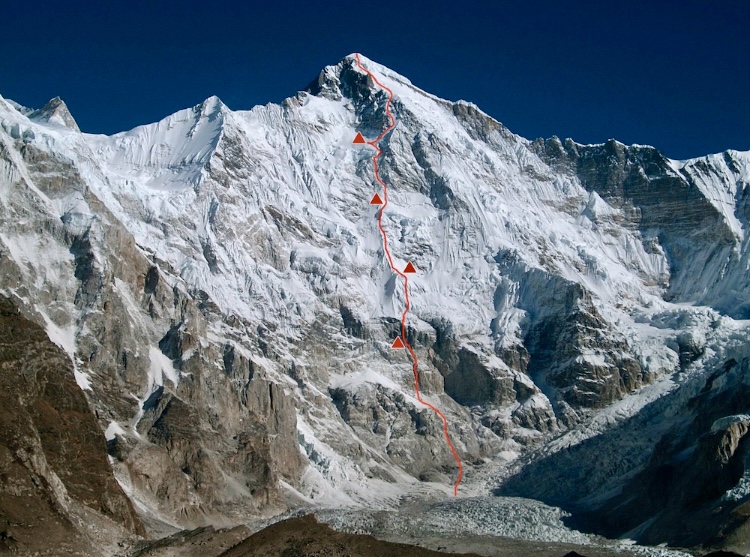
The 2009 direct Southeast Face route, climbed by Denis Urubko and Boris Dedeshko. Photo: Denis Urubko
The summit push
They left Base Camp on May 6, reaching ABC at 5,300m. At midnight, they tackled the Southeast Face from 5,600m, climbing steep rock (50º to 90º, sometimes overhanging) amid avalanches and falling rocks.
On May 7, they bivouacked at 6,000m on a tiny ledge, enduring wind and snow.
“The world narrowed to dimensions of a dull glass box 10m a side,” Urubko wrote, capturing the claustrophobic intensity.
They progressed to 6,600m, then to 7,100m, bivouacking under seracs and bergschrunds as a storm raged. On May 10, they navigated a rock band at 7,300-7,500m before stopping at 7,600m.
On May 11, despite worsening weather, Urubko and Dedesho summited at 8:10 pm via deep snow and avalanche-prone couloirs. Urubko, completing his 14th 8,000m peak, felt “empty and transparent, like glass.”
A dangerous descent
The descent was perilous. Avalanches buried their tent, and a rock struck Urubko’s head. By May 14, they reached Advanced Base Camp, returning to Base Camp on May 15, exhausted and frostbitten. With only 1,200m of rope, reused throughout, they left no gear behind. Urubko called it his most dangerous climb.
They named their 2,600m route (6b A2/3 M6 with steep snow and ice) Reincarnation. Here is their exciting report in the American Alpine Journal.
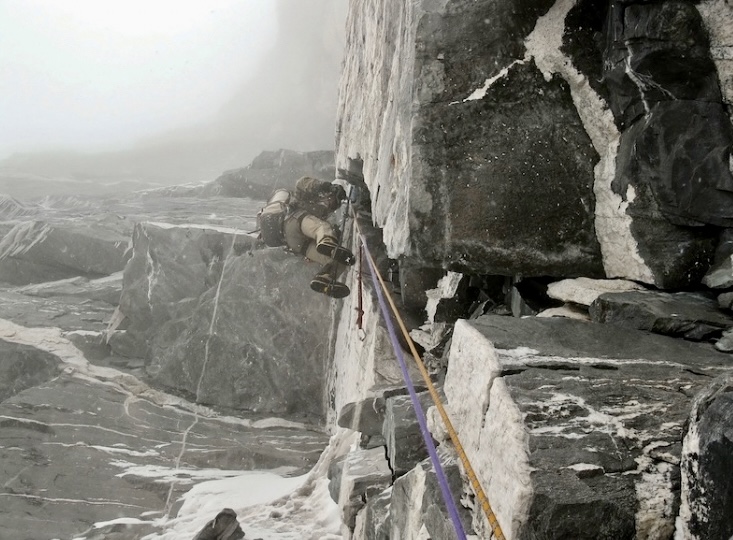
Denis Urubko on Cho Oyu in 2009. He spent most of the second day aid-climbing an overhanging 80m headwall. Photo: Boris Dedeshko
After the Urubko-Dedeshko climb of 2009, there were no successful ascents from the Nepalese side of the peak until 2024. In 2022, Gelje Sherpa’s team climbed from Gokyo but stopped at 7,400m because of avalanches. In 2023, from Thame, they hit 7,600m, but the weather won. A Russian team led by Andrey Vasiliev tried the South-Southwest Ridge in fall 2023 and spring 2024, reaching 7,200m each time.
In 2024, a Seven Summit Treks team with Alasdair McKenzie, Tenjing Gyalzen, Lakpa Temba, Lakpa Tenji, Ngima Ongda, Chhangba, and Gelje Sherpa established a route by the South-Southwest ridge. This team used supplemental oxygen.
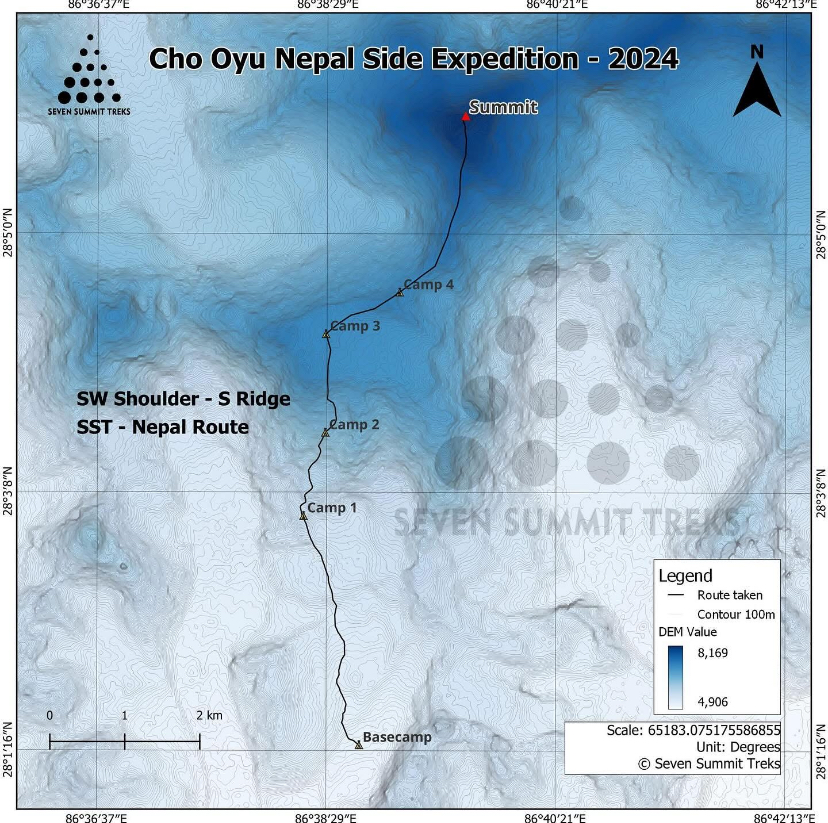
The 2024 route on the southern side of Cho Oyu. Photo: Seven Summit Treks
A couple of days ago, Czech climbers Marek Holecek and Radoslav Groh arrived at Cho Oyu, aiming to open a new alpine-style route up the Southeast Face.
